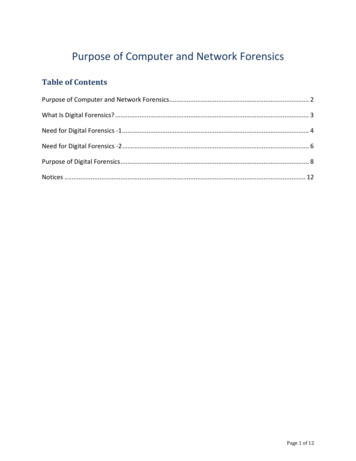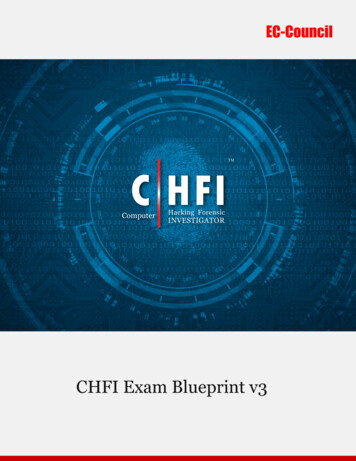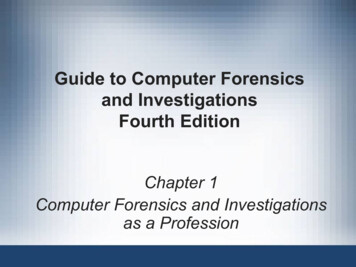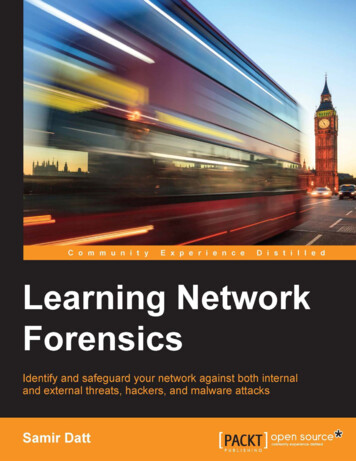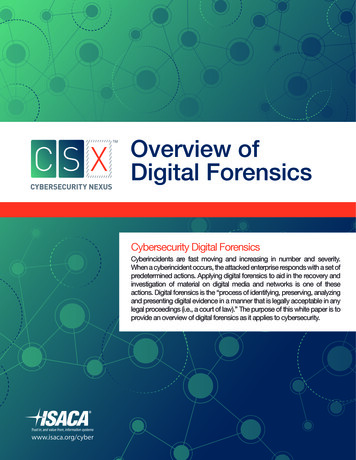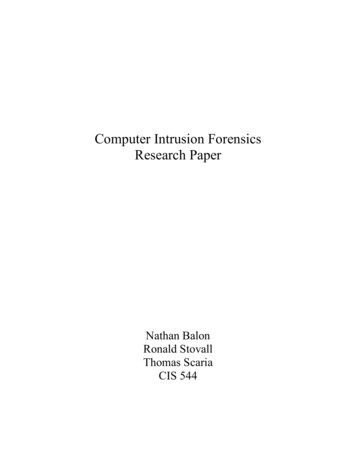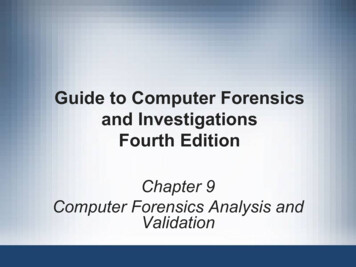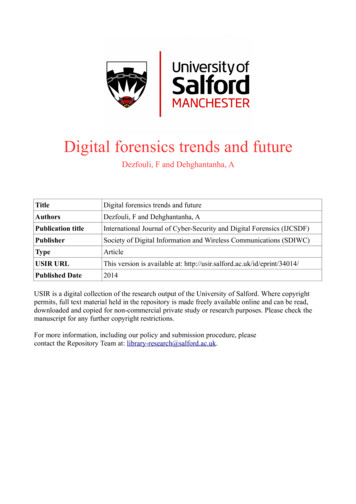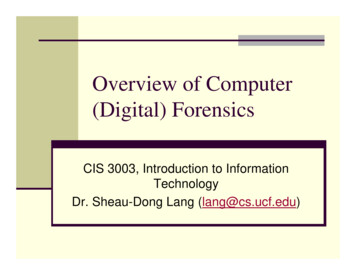
Transcription
BioMathCrime: Criminal Investigationthrough Mathematical ExaminationStudent Edition
Funded by the National Science Foundation,Proposal No. ESI-06-28091This material was prepared with the support of the National Science Foundation.However, any opinions, findings, conclusions, and/or recommendations hereinare those of the authors and do not necessarily reflect the views of the NSF.At the time of publishing, all included URLs were checked and active.We make every effort to make sure all links stay active, but we cannot makeany guaranties that they will remain so. If you find a URL that is inactive,please inform us at info@comap.com.DIMACSPublished by COMAP, Inc. in conjunction with DIMACS, Rutgers University. 2015 COMAP, Inc. Printed in the U.S.A.COMAP, Inc.175 Middlesex Turnpike, Suite 3BBedford, MA 01730www.comap.comISBN: 1 933223 72 3Front Cover Photograph: EPA GULF BREEZE LABORATORY, PATHO-BIOLOGY LAB. LINDA SHARP ASSISTANTThis work is in the public domain in the United States because it is a work prepared by an officer or employee of theUnited States Government as part of that person’s official duties.
CRIME: Criminal Investigation through Mathematical ExaminationOverviewWelcome to our unit on the mathematical examination of fingerprints! This unit is provides apossible method to identify individuals in a species. Tracking individuals can be an importantstep in learning more about the species as a whole. This unit concentrates on human fingerprints.To accomplish this, we use a fictitious crime case to explore a mathematical procedure toexamine and compare fingerprints. The unit consists of multiple activities to investigate thecharacteristics of a fingerprint and the biology behind why everyone’s fingerprints differ.Goals and ObjectivesGoal: Students will understand the importance of identifying individuals within a species.Objectives: Explain the importance of being able to identify individuals within a species. State the types of fingerprints that can be left at a scene. Explain the general sequence of investigation from crime scene to identification.Goal: Students will understand how genetics and environment can interact to ‘individualize’traits such as fingerprints.Objectives: List and identify the three basic layers of the skin. State that fingerprints arise from the dermal papillae. Evaluate the importance of fingerprints arising from the dermis rather than the epidermis. Define epigenetic, penetrance and expressivity. Describe ways to alter a gene’s expression either genetically or environmentally. Explain why even identical twins do not have identical fingerprints.Goal: Students will understand how to approach a problem by first looking at general patternsand then looking in more and more detail to observe similarities and differences.Objectives: Identify the fingerprint pattern of a given print. State the relative frequency of the three basic fingerprint patterns. Define and identify the ‘delta’ and ‘core’ of a fingerprint. Analyze a fingerprint and apply the primary and secondary classification values of thePOP system.Goal: Students will understand the importance of applying scientifically and mathematicallyrigorous solutions to problem-solving. Explore connections between the mathematical and biological sciences. Use graphs and matrices to match fingerprint characteristics.Crime and ForensicsStudent 1
Lesson 1Fingerprinting BasicsBroadly speaking, forensic science is the analysis of traces of evidence such as body fluids, glassfragments, footprints, and drugs left at the scene of a crime by the criminal, victim or others. Theevidence may be used subsequently to either implicate or exonerate a person suspected ofcommitting that crime, or just to gain further insight into the incident.Forensic science involves more than just identifying traces of evidence. Sometimes it isn’tobvious just what is a piece of evidence. Important questions that need to be answered are:How did the evidence come to be at the crime scene?From where did the evidence originally come?Who left it there?This suggests a natural role for statistics and mathematics, as these questions can only beanswered in terms of probabilities. So it is not surprising that the primary task of forensicstatisticians/mathematicians is to evaluate any evidence found at a crime scene, so that thisevidence can be appropriately presented to a jury in court.The following are some of the fields associated with forensic ogyChemistryMathematicsStatisticsComputer riminal JusticeMedicineCrime Case Part 1: The StoreMany times when police receive the report of a possible crime, they call forensic investigators tothe scene. These investigators determine, through examination of forensic evidence, whether theincident is suspicious and requires further investigation, or if it is an accident. They determinewhether there are any victims or suspects involved in the occurrence. The following is aconversation between two investigators concerning an incident that has occurred at a local store.Frank: Why do I always seem to be the one on duty during full moons? Clearly seniority means nothing in thistown. And this rain and darkness is not helping. I sent Frank a text ten minutes ago. He should be here soon.Barney: Hey Frank, I got your text, what’s up? Oh yeah, I heard a good one today. What can run but neverwalks, has a mouth but never talks, has a head but never weeps, and has a bed but never sleeps?Frank: Really Barney? Maybe now isn’t the best time for riddles.Barney: Whoa, look at that. There is a car in the middle of the store. How did that get there?Frank: Perhaps someone drove it there Barney, but that’s just a guess.Crime and ForensicsStudent 2
Barney: But there is no one in the car?Frank: Nice call, Captain Obvious, they seem to have fled.Barney: Yikes! Someone must’ve been a little angry at the store, eh?Frank: It would certainly seem that way, or angry with someone in the store.Barney: Any ideas on who should be in our suspect list?Frank: I have a few ideas on where to start, but we’ll need more info on who was driving the car.Barney: Any evidence to suggest who that might be?Frank: Not yet, but we are searching for evidence in the car. We’ve got a CSI team on it now. They should letus know by tomorrow.Barney: What are they looking for?The investigation begins with a general assessment of what constitutes and what does notconstitute forensic evidence. After that assessment, the team begins collecting that evidence.Questions for Discussion1. What kinds of information might the investigators obtain from the car that could be used toidentify the driver?2. If investigators do find some evidence in the car, whom should they compare it to? In otherwords, who do you think should be on the initial suspect list?3. Fold your hands and place them in your lap or under the table (do not look at your hands).a. Starting from your fingertip, how far down your finger do you think your prints go? (e.g.first knuckle, second knuckle, etc.)b. Do you have prints on the back on your fingers?c. Why do you have fingerprints? What is their purpose?d. Where else would you find “prints” on your body?Crime Case Part 2: The EvidenceAll areas of friction skin on our bodies (fingerprints, palms, toes and soles of the feet) arepermanent and unique. So, they do not change over time and they allow for individualization.Although television shows have popularized the method of “dusting” a print (using a fine brushalong with a special powder), in fact this method is no longer the method of choice. ModernCrime and ForensicsStudent 3
technologies have seen the use of digital imaging. Nevertheless, older methods are used whennothing else is available. For instance, it is possible to “lift” a print with clear tape.It is important to preserve the details of a print as clearly as possible so that a good match can bemade. The better the impression, the better it will be to clearly identify distinguishingcharacteristics. Digital imaging has vastly improved the ability to record fingerprint detailsclearly.Collection methods also depend on the type of fingerprint. Some prints are latent, meaning theyare not visible to the naked eye. A patent print is visible, being left in some medium such asblood, ink, grease, etc. Impressed prints (also called plastic prints) are indentations left in softpliable surfaces such as wax, clay, paint, etc. As you might imagine, each of these types of printshas its challenges and advantages.When fingerprint evidence is collected at a crime scene, investigators’ first step is to search anational database to see if there is a copy of that print on file, thus identifying the personassociated with the print. The evidence may belong to the person responsible for committing thecrime. The print may just belong to an innocent victim who was in the wrong place at the wrongtime. Or the print may not have anything to do with the crime. Additional evidence may beneeded to corroborate the investigators’ conclusions.Back to the crime Barney: Hi Frank, did they find any evidence in the car?Frank: Yes, they found some fingerprints.Barney: Great, who do they belong to?Frank: I’d like to be able to tell you but the lab says they are very backed up and our case isn’t exactly high ontheir to-do list.Barney: Well it is high on our to-do list so what are we going to do?Frank: I had a friend send over one of the partial prints they found so we can take a look.Barney: I hope you have ‘brushed up’ on your fingerprint skills, ha, get it?Frank: Very funny Barney, very funny. I know some people at a private lab who might be able to help us. I’llsend the print over to them. I’ve also put together a suspect list.Crime and ForensicsStudent 4
Figure 1.1: Print Sent to the LabMuch of the mathematics in future lessons of this unit deals with methods for searching adatabase for a fingerprint match. However, before you examine the search algorithms used bylaw enforcement you need to study the process of taking and recording fingerprints.Activity 1-1 Fingerprinting 101Objective: Complete a fingerprint card.Materials:Fingerprint recording sheetsNumber two pencils and sharpener (if needed)5 by 7 index cardsClear wide scotch tapeMoist sanitary towelettesHandout CF-H1: Fingerprinting 101 Activity Worksheet1. Each member of the group fills out a fingerprint recording sheet. Partners should sign eachother’s fingerprint sheets as the official taking the fingerprints. Follow the directions in 2-7below for each group member.2. Take the number 2 pencil and rub it on the index card until there is a solid smudge of leadlarge enough to cover a fingertip.3. Rub your finger on the lead smudge firmly, but not too firmly, until the fingertip is completelycovered. You must cover your finger from the tip to the first knuckle and from one side to theother side, so be sure to roll your finger in the pencil lead from side to side (nail edge to nailedge). Start with the right thumb.4. Once your finger is sufficiently covered, you are ready to place your fingerprint in theappropriate box on the card. Locate the spot for your right thumb on the fingerprint card. Placeone edge of your thumb in the box, press firmly and roll your finger to the opposite edge (nail tonail). Do NOT roll it back again or you will smudge the print. Be sure to keep your fingerparallel to the table to get as much of your print as possible onto the card.5. You may wish to place a piece of scotch tape over the print to protect it from damage (unlessyou used fingerprint ink rather than pencil lead).Crime and ForensicsStudent 5
6. Repeat this process for each finger until you have a complete set of fingerprint impressions.7. At the bottom of the card there is a spot to press all four fingers at the same time as well astwo spots for each thumb. This is a safety check to be sure that each finger was put in the correctbox above.Practice1. Use your fingerprint cards to look for patterns. How many different ‘patterns’ do you see onyour prints? For example, is the pattern the same on all 10 fingers for a particular individual?How about on just one hand? Both index fingers? Come to class tomorrow ready to discuss yourfindings.2. Check the Internet for information on fingerprinting. Find one example of when fingerprintingcan be helpful in solving a crime and one example when fingerprinting can be problematic insolving a crime.3. The investigators were able to put together a list of possible suspects as to who may havedriven the car into the store. Consider the following suspects and make your prediction of the topthree suspects.a. John McDonnell – the storeowner who is struggling to keep up with the rent.b. Christine Smith – a recently fired employee for smoking in the store with Frank Cooper.c. Frank Cooper – also recently fired along with Christine Smith.d. Lee Howe – an employee who was recently docked in pay for falling asleep in thedressing room.e. Steven Riale – an employee recently accused of stealing candy from the store but theycould not prove it. So now he is being watched ‘like a hawk’.f. George Munson – a competing store owner who has recently threatened John McDonnellto stop telling people lies about George’s store, “or else!”g. Caroline Fletcher – John McDonnell’s ex-wife who is angry with him being behind inalimony payments.h. Kathy Sullivan – a recent customer who tried to return an item she just purchased the daybefore but lost her receipt. The store did not accept the return and she was overheardsaying, “You’ll pay for this!”i. Rick Dawson – the car owner who says his friend borrowed the car that night.j. Darryl Wright – the friend who borrowed the car. He was in a bar that night and sayswhen he came out the car had been stolen.k. Jeremy Dawson – the 16-year-old son of Rick who frequently sneaks out with the car.l. Lin Huang – the employee of the month, for 14 straight months.m. Linda Pierce – the runner up for employee of the month for 14 straight months.n. Andy King – the 41 year old and longest employee (18 years) who was promised hewould be store manager one day (16 years ago) and is still a stock ‘boy’.o. Susan Tilly – a female employee whose health insurance was cut just one week beforethe birth of her triplets.p. Ivan Carlson – the ex-boyfriend of Susan who recently got out of jail.Crime and ForensicsStudent 6
q. Donald French – an employee, the current boyfriend of Susan and probable father of thetriplets.r. Sadie Wiler – a local criminal who has a history of stealing cars.s. Teddy “Thunder” Chow – a local criminal who has a history of burglarizing stores.t. Thomas Calvin – the high school jock who went out ‘partying’ last night and no one canseem to find.u. Sarah Spencer – the local jock’s girlfriend, who is also currently missing.Crime and ForensicsStudent 7
Source: FBI is a Government Agency. Image is in the Public Domain.Figure 1.2: Fingerprint CardCrime and ForensicsStudent 8
Lesson 2Fingerprint Pattern RecognitionTaking a closer look at fingerprints, we can clearly define the patterns found in fingerprintimpressions. Fingerprint patterns contain certain features that allow us to classify fingerprintseasily into three primary categories.Fingerprint Features and PatternsLet’s begin by defining the two features that are used to distinguish one major pattern type fromanother: deltas and cores. Deltas and cores are formed by ridge patterns.A delta is triangular-shaped ridge pattern that appears at the center of three intersecting ridgeflows. A core is the termination of the innermost ridge that appears in the interior of a concentricset of curved ridges. A fingerprint ridge is a slightly raised, long, narrow line or curve thatappears on the surface of the skin.Figure 2.1: Examples of DeltasFigure 2.2: Examples of CoresThere are three main patterns within fingerprints: arches, loops, and whorls. The maincategories of patterns found on fingerprints are classified according to the number of cores anddeltas present in the pattern.Crime and ForensicsStudent 9
The following figures show examples of the three patterns of fingerprints. Examine the figuresand compare their differences.Figure 2.3: Example of Plain Arch (left) and Tented Arch (right)Figure 2.4: Example of Loop (left) and Whorl (right)Sfinge finger print graphics from University of Bologna reprint permission is granted from Professor MaioCrime and ForensicsStudent 10
Practice1. What pattern is shown by each of the fingerprints below?a.2. What pattern is the following?b.c.Sfinge finger print graphics from University of Bologna reprint permission is granted from Professor MaioActivity 2-1 Classifying FingerprintsObjective: Identify distinguishing patterns in fingerprints and classify fingerprints.Material:Handout CF-H2: Classifying Fingerprints Activity WorksheetHandout CF-H3: Database of Suspect FingerprintsPart I: Examine Fingerprint Samples1. Examine the three columns of fingerprint samples in Figure 2.5. Count the number of coresand deltas in each print and record the number in the corresponding column.2. Compare the numbers you counted in part 1 with your other group members. Are your countsthe same or different? If different, why?3. Discuss with your group and annotate any observations about whorls, loops and arches.4. What can you conclude from your numbers in relation to the fingerprint patterns you see?Crime and ForensicsStudent 11
Part II: The Pattern Ordered Pair (POP) Classification SystemFor the purposes of this activity we will create our own system of categorizing fingerprints.1 Wewill use the following classification system, referred to here as the Pattern Ordered Pairs (POP).The POP system will use several features of prints in the classification process. In fact, the POPsystem is a multi-stage process, as are systems actually in use by law enforcement agencies. Thefirst step, called the primary classification, is to write the ordered pair (C, D), in which represents the number of cores present in the pattern, and represents the number of deltas present in the pattern.5. Calculate the primary classification ordered pair, (C, D), for each of your ten fingers on yourown fingerprint card.6. Calculate the primary classification ordered pair, (C, D), for the subset of database suspects asassigned by your teacher.Questions for Discussion1. How common is each type of print within our own class? How many of your prints are loops?Whorls? Arches?2. How does our class data compare to larger population studies?1The reason for this is the limited database that we are using does not require the complete complexity of the HenrySystem, the extension of the Henry system, or recently employed systems by federal agencies such as ridgedistribution systems. Although our system is simpler, it still reflects the process by which fingerprint experts woulddetermine likely suspects through an algorithmic process of elimination.Crime and ForensicsStudent 12
Fingerprint# ofCores# ofDeltasFingerprint# ofCores# ofDeltasFigure 2.5: Fingerprint SamplesCrime and ForensicsStudent 13Fingerprint# of Cores# ofDeltas
Pattern RefinementThe three main patterns are subdivided into subcategories. In Figure 2.3 you saw that there aretwo types of arches: plain (no cores) and tented (one core). There are also two types of loops:ulnar (the loop slants, top to bottom, toward the ulnar side of the hand) and radial (the loopslants, top to bottom, toward the radial side of the hand). There are four types of whorls: plain(one core, the line segment joining the deltas intersects some of the curled ridges), central pocket(one core, the line segment joining the deltas falls below the curled ridges), double loop (twocores), and accidental (two cores and three deltas).Loops are classified by the fact that they have one core, one delta, and the ridge count. In a looppattern one or more of the ridges enters on either side of the impression, recurves, touches orcrosses the line segment joining the core to the delta. Loops are of two types: Radial & Ulnar.Radial loops slant toward the radial (thumb) side of the hand. Ulnar loops slant toward the ulna(pinky finger) side of the hand. What type of loop is shown in the following figure?CoreDeltaFigure 2.6: ? LoopWhorls are characterized by having two or more deltas and the ridge count. A plain whorl and acentral pocket whorl consist of one or more ridges that make a complete circuit, with two deltas.If one were to draw a line segment connecting the two deltas: In a Plain Whorl the line segment joining the deltas intersects some of the ridge circuits. In a Central Pocket whorl the line segment joining the deltas falls below the ridge circuitsA double loop whorl consists of two separate loop formations, with two separate and distinct setsof “shoulders”, two cores, and two deltas. An accidental whorl has two cores and three deltas.Crime and ForensicsStudent 14
Figure 2.7: Whorl FingerprintsPractice3. We’d like to narrow down the list of suspects. The fingerprint database contains all the printson file for the people from the community, including the possible suspects for the crime (but notlimited to just those suspects). Calculate the primary classification ordered pair (C, D) for five ofthe remaining database prints beyond the ones your were assigned in Activity 2-1.4. Look again at your own fingerprints. Further classify your prints in terms of any types ofarches, loops and whorls you can identify.Crime and ForensicsStudent 15
Lesson 3The Process of EliminationThe Pattern Ordered Pair System of ClassificationYour activity and practice in the previous lesson included calculating the primary classificationfor fingerprints in the crime database. We can now calculate the primary classification for eachof the crime scene fingerprints.Identifying a likely suspect from a database of fingerprints uses a process of elimination. Thefirst step in the process of elimination is to compare the primary classification of fingerprintobtained at the scene with the primary classifications of the fingerprints in the database. Anysuspect whose primary classification differs from the primary classification of the fingerprintobtained at the scene can be eliminated as a possible suspect.Did You Know?The United States Federal Bureau of Investigation categorizes complete sets offingerprints using several component parts of the Henry classification system.[1,2]1. The Primary.2. The Secondary.3. The Sub-Secondary.4. The Major.5. The Final.6. The Key.This system of classification is still in use in many parts of the world. However, withtechnologies developed in the 1990’s this system has begun to be replaced by moretechnologically advanced systems such as Ridge Distribution Systems.Activity 3-1 The Primary ClassificationObjective: Use the POP system to classify and eliminate suspects.Material:Handout CF-H4: The Primary Classification Activity WorksheetHandout CF-H3: Database of Suspect Fingerprints1. As a class, agree upon and record the classifications of each fingerprint in the suspectdatabase.2. Calculate the primary classification using our POP system for the fingerprint obtained at thescene using the POP method.Crime and ForensicsStudent 16
3. Compare this primary classification with the primary classifications for each print in thedatabase. Any fingerprint in the database that does not match the primary classification of thefingerprint found at the scene can be removed from consideration. How many prints from thedatabase have the same primary classification as the fingerprint found at the scene? Which onesare they?4. Which of the remaining fingerprints belong to individuals in our suspect list? Which suspectsdo not have the same primary classification as the fingerprint found at the scene? Can they nowbe eliminated as suspects?Questions for Discussion1. What are some of the aspects of the fingerprint found at the scene that may help or hurt infinding a unique match from the database?2. Is the primary classification enough to identify a single suspect? Explain.Fingerprint UniquenessAren’t You Glad Dr. Faulds is Not Your Teacher?In the late 1800s, Dr. Henry Faulds conducted an experiment with his medical students.In this experiment he had them rub their fingertips with pumice stones (like sandpaper)until they rubbed off their fingerprints. Then they waited to see if They would grow back?If they grew back – were they the same?What do you think about Dr. Faulds experiment? What do you think happened?There are 3 basic layers of skin – the epidermis (outermost), dermis, and hypodermis (innermostlayer that is mostly fat). The epidermis is subdivided into 5 layers, which is why you may haveheard we have 7 layers of skin. But for this module we only need to break the skin into 3 layers.Figure 3.1: How Do Prints Grow Back the Same?Crime and ForensicsStudent 17
The dermal papillae are the ‘bumps’ at the top of your DERMIS. These bumps are then coveredby your epidermis and show through as your fingerprints. Therefore, if you only damage theepidermis, your fingerprints will grow back exactly the same because the new epidermis will layback over the same bumps.It is possible to damage the skin deeply enough that you destroy the dermal layer and lose thefingerprint in that region. Deep cuts and bad burns may do this. There will be a scar at thatportion of your print, but the rest of the print will still be the same as before. Potentially, youcould damage or burn off your entire print. The skin will then probably be shiny and tight andmore slippery when you pick up things.Questions for Discussion3. What determines the pattern of dermal papillae and therefore the pattern of fingerprints?4. Do identical twins have the same DNA? Do identical twins have the same fingerprint patterns?Penetrance refers to the fact that the same gene (genotype) may, or may not, be expressed in thephenotype of different individuals. In other words, one individual may express a trait while asecond individual, with the same gene/allele, may not. This is likely due to either an epigeneticinteraction or an interaction with the environment. Epigenetics refers to modifications in a gene’sexpression (rather than modifying the gene itself). These modifications can include DNAmethylation, which effectively turns off the gene, and post-transcriptional modifications that canaffect the production of the protein for which the gene encodes.Source: Biology MOOC by Robert Maxwell is licensed under a Creative Commons Attribution-NonCommercial-ShareAlike 3.0 12 03 01 archive.htmlFigure 3.2: Penetrance vs. ExpressivityFigure 3.2 shows the effects of penetrance and expressivity through a hypothetical character“pigment intensity.” In each row, all individuals have the same allele—say, P—giving them thesame “potential to produce pigment.” However, effects deriving from the rest of the genome andfrom the environment may suppress or modify pigment production in an individual.Crime and ForensicsStudent 18
Questions for Discussion5. Take a closer look at the 28 remaining prints. Although all of these prints have the sameprimary classification, and thus the same loop pattern, there are differences among the loops oneach of the prints. Examine the loops from the 28 prints that remain from the database moreclosely. What are some differences that you notice among the loops?6. At this point are you confident that those people who have been eliminated as suspects areindeed innocent?Secondary ClassificationIt is clear that the primary classification is not enough to identify a suspect. Ideally a finalcomparison should be made between fingerprints found at a crime scene and as few prints fromthe database as possible. The next step is to reduce the database even more so that just a fewprints remain as likely suspects. To do this it will be necessary to calculate the secondaryclassification. The secondary classification can be thought of as a way of measuring thedifference in size of the general pattern and the direction (left or right) of the general pattern.As you have seen, even though two prints may both be (1, 1) loops, they may still be visiblydifferent. For example, the number of ridges that fall between the core and the delta on a loopcould be different for distinct prints. That is, the primary classification process of the POPsystem is not enough to distinguish among similar-looking prints. Therefore we introduce thesecondary classification process of the POP system.To carry out the secondary classification process, begin by drawing a straight line from thecenter of each core to the center of each delta. For a (1, 1) print, that is just one line, but for otherprimary classifications you may need to draw several lines. The center of a core is the centerridge ending at the heart of the core. The center of a delta is the ridge ending or the “fork” of aridge that occurs within the delta. Figure 3.3 provides an example.Crime and ForensicsStudent 19
CoreDeltaFigure 3.3: Line Connecting Core and DeltaFor each line you drew, count the number of ridges that it crosses (DO NOT count the core itselfor the delta itself). If it happens to cross a point where a ridge splits into two ridges, count that astwo crossings. Record your count as positive if the slope of the line is positive, and record yourcount as negative if the slope of the line is negative.The secondary classification is now defined as the ordered pair (M, m), where M represents thelargest (in absolute value terms) count among your lines and m represents the smallest (inabsolute value terms) count among your lines. Note that when calculating M and m for archesand loops, the maximum and minimum counts are the same, M m, because there is at most oneline segment. For
Crime and Forensics Student 2 Lesson 1 Fingerprinting Basics Broadly speaking, forensic science is the analysis of traces of evidence such as body fluids, glass fragments, footprints, and drugs left at th
